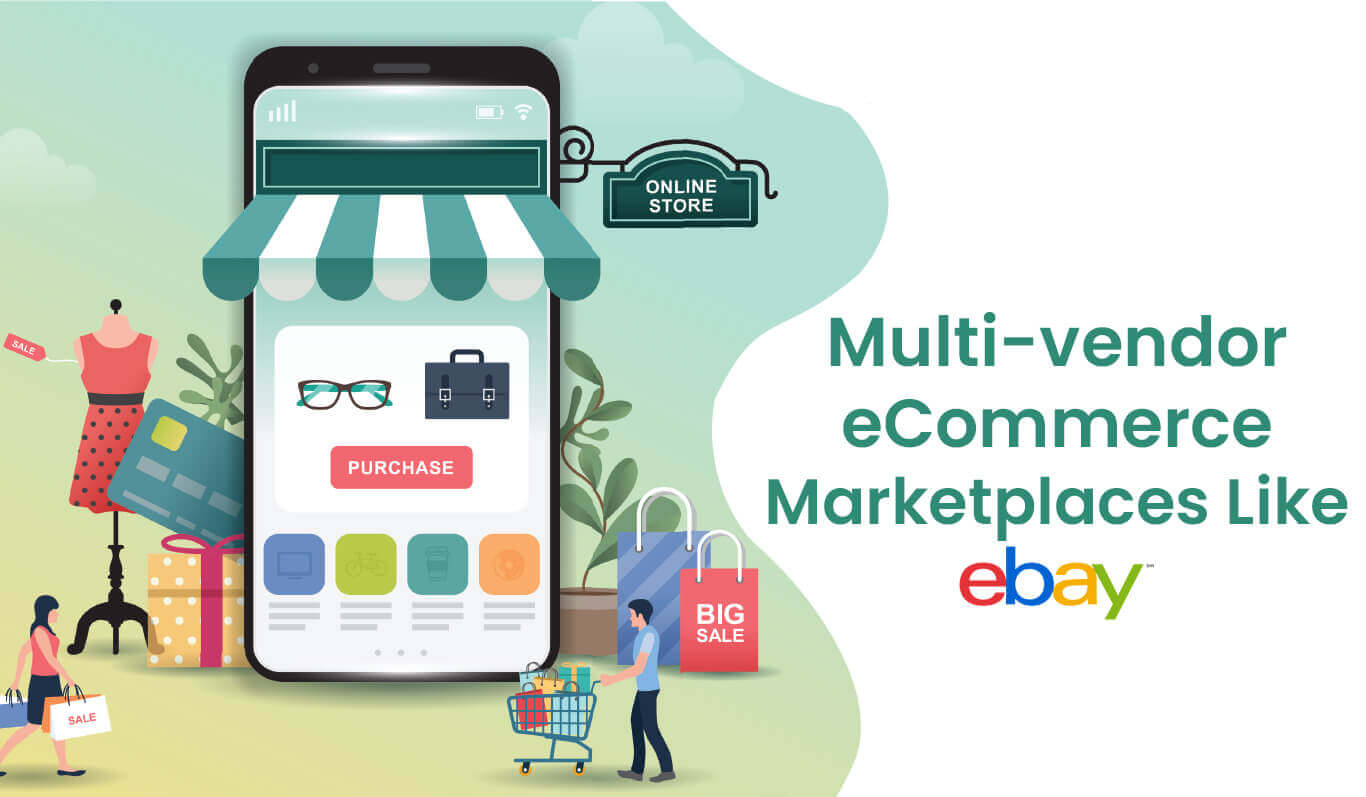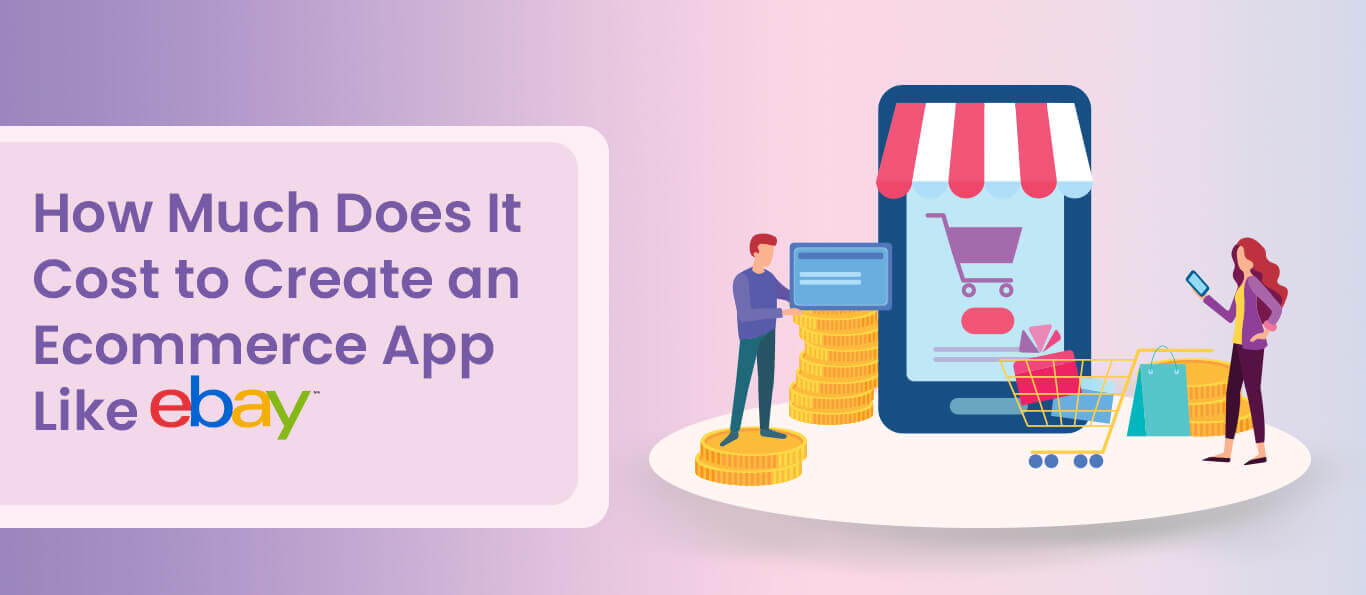Multi-vendor eCommerce Marketplaces Like eBay Cost & Features

The king of e-commerce, eBay was established in 1995. In today’s era selling both physical and digital goods on an online marketplace is common. In the second quarter of 2022 around 138 million active purchasers on the US e-commerce site eBay.
eBay has created out a special space for itself online by handling B2C and C2C. Unlike a traditional marketplace for buying and selling goods. Entrepreneurs are searching for business opportunities to create an online marketplace. There is such a huge demand for e-commerce websites like Amazon and eBay.
Almost all offline shoppers suddenly switched from auction platforms to online marketplaces. It’s because eBay provided an excellent quality, punctuality, and a delightful purchasing experience, all of which benefited customers to shop online.
But how do these well-known multi-vendor marketplaces encourage to build an eCommerce website? Customers enjoy shopping in an online marketplace because they can buy a wide range of products from various merchants that sell various brands.
Successful story of eCommerce App eBay

eBay is the US's top-ranked online multi-vendor marketplace. In 1995, eBay was started as a passion that has grown into a massive e-marketplace. Software engineer Pierre Omidyar started an online platform called Auction Web, which listed a few basic used things for sale.
Omidyar renamed the business eBay in the second quarter of 1997 and began spending money on advertising. The eBay marketplace has been growing internationally for 25 years. Currently it offers billions of items in a variety of categories. In fact, the auction website grew so quickly that it eventually purchased firms like Skype, Craigslist, and PayPal. Currently, eBay presents itself as a multi-seller auction platform online where e-commerce companies and consumers may sell.
eBay uses a different business strategy than Amazon, which works as a direct seller of items, giving suppliers certain advantages. Customers can create an auction listing or set a fixed price for their goods. This platform is advantageous when vendors encounter little supplies and great demands. Buyers can place bids on the products they've chosen, and sellers profit more from it.
eBay offers more affordable pricing and customer-focused services. The platform depends all on sellers to succeed. Sellers can build up their own account policies and design their marketplace website. eBay enables sellers to manage their own shipping costs and return procedures.
eBay Revenue Model
eBay was the first online marketplace with a vast selection of items, and it is now accessible in 180 countries. Other multi-vendor eCommerce marketplaces similar to Amazon are successful, but eBay stands apart.
Both buyers and sellers have access to this platform, which allows them to participate in the same offer and buy or sell things. The overall income is generated by listing items and receiving particular commissions when those things are sold.
- Listing Cost Model
Every seller on eBay is given free access to list a minimum of 200 goods on the online marketplace platform. When the limit is reached, eBay charges a $0.35 listing fee also known as an insertion fee for each listing.
- A revenue model based on commission
Every sale that a seller on the marketplace makes generates revenue for eBay. This commission is paid as the Final Value Fee and is calculated as a percentage of the final selling price plus $0.30 for each order.
- A revenue model based on advertising
eBay receives income in addition to listing fees and commissions on profitable sales. In exchange for payment, the platform allows vendors to promote their goods on eBay.
Key Features for Multi-Vendor eCommerce Marketplaces Like eBay
- User Registration
On multi-vendor eCommerce platforms, the two main user roles are buyers and sellers. Any multi-vendor eCommerce marketplace software must have the proper location for user updates and information. Buyers are required to provide their name, email address, password, and occasionally other contact information. The delivery address and payment method are necessary in order to move on. However, these platforms include services like order history, Wishlist, and others. Sellers using the eBay B2B eCommerce platform must submit their name, address, phone number, tax information, and other necessary details.
- User Mobile Friendly
Approximately 56% of all web traffic around the globe comes from mobile apps, according to a survey. Multi-vendor eCommerce solutions must be accessible on mobile devices as this is how the majority of customers browse and place orders. By building a responsive multi-vendor eCommerce marketplace, you can be sure that your website works properly on all major web browsers.
- Place Order
In today's eCommerce sector, features like the button for placing product orders are the game changer. Customers provide billing, shipping, and payment information before clicking to place their order. The success of the project depends on provide customers with a simple and comfortable ordering process. Customers should have access to an area where they may review their order history when placing a second order, changing the language, or receiving customized offers.
- Transparency
Shipping is a crucial element of any online business. Give customers options to select their desired shipping method and delivery timeframe. On multi-vendor marketplaces, client trust is increased by a convenient delivery time and clear delivery. The online marketplace enhances the user experience with a live tracking tool. Customers hate purchasing from platforms that hide delivery costs, so it’s important to indicate clearly what you're charging for shipping.
- Sellers Product Pages
Sellers can easily build new items on marketplaces and sell them. Businesses can provide information on a variety of topics, including price, quality, availability, warranty, size, and shipping information. Customers can decide which products to purchase based on their needs, and the product description is crucial.
- Customer’s Feedbacks and Reviews
Customers while purchasing a new item, heavily rely on ratings and reviews. A platform becomes more genuine when it has features like IP address verification and review acceptance mainly from registered users. Markets like eBay even respond to reviews and request more input from customers
- Easy Payment Method
Customers' excitement has risen as a result of digital advancements. To improve the consumer experience, provide customers with a variety of payment methods. The ability to pay with credit cards, debit cards, net banking, UPI, e-wallets, and even cryptocurrencies is now provided by platforms. The best payment gateways increase customer loyalty and drastically lower cart abandonment rates.
How Much Does It Cost to Create an Ecommerce App Like eBay

Pricing Factors that are involved in creating an app like eBay Numerous factors are involved in the creation process, which directly impacts the price of the finished website. These include choosing a technological stack and designing it.
Business Necessities
When creating a website, the development team must consider the demands of the stakeholders into account. The development team has to work on a variety of scenarios. The number of phases involved in the development process and related expenses can change correspondingly.
Website And Feature Complexity
While developing a website like eBay a variety of services are included shipping, chatbots, and payment methods. Each of them has a 30% or more effect on development costs. Implementing necessary functionality costs between $15,000 and $25,000; implementing more features is more expensive.
Marketplace Size
A Website requires a number of services, including hosting, backup, and file storage. These services typically cost between $5,000 and $15,000 and will have a significant impact on development costs. It is essential to take into account these factors while creating a multi-vendor marketplace since they impact the size.
Technologies
An Appropriate technological stack has to be used for the website to perform successfully in the market. The technology stack and development methodology will have a direct impact on the ultimate cost of between $15,000 and $40,000.
UI/UX
Understanding user experience and user interface design is necessary for the creation of an online marketplace like eBay. The performance of the site will be determined by how well the user interface functions. A unique design will often cost you between $10,000 and $25,000. The development costs of a full-featured marketplace like eBay will range from $30,000 to $100,000.
Here's How Neetable Can Simplify Your Developing Task
You need skilled developers to build multi-vendor eCommerce marketplaces similar like eBay this is not an easy task. Considering the intense competition in the eCommerce Marketplace software industry, trust Experts. Are you ready to establish a multi-vendor business? One of the top mobile app development firms, Neetable renowned only for developing incredible multi-vendor marketplace. With the help of technological tools, web design, mobile app development, and technical support, we enhance our consumer experience. Are you the next eBay?
FAQ’S
What is multi-vendor ecommerce marketplace?
An online store with multiple vendors provides a platform for the sale of goods and services. This kind of marketplace is also frequently referred to as an "online marketplace" or a "marketplace model." Amazon, eBay, and Etsy are a few of the most well-known examples of multi-vendor e-commerce platforms.
How do you market a multivendor marketplace?
- The first thing you should do is promote on social media.
- Advertise Ads.
- Promoting to the Correct Audience.
- Get in touch with your vendors directly.
- Rely on word-of-mouth
Request a Quote
Categories
Popular posts
Best Practices for Software Product Engineering Every CTO Should Implement
2023-14-18How to Build Your Own On-Demand Carpooling App Services?
2023-08-25How to Start an On-Demand Fuel Delivery Business: A Comprehensive Guide
2023-07-28Empowering Miners: How Fleet Management Apps are Transforming the Mining Industry?
2023-07-21A Complete Guide to Develop a Food Delivery App for Restaurants in 2023
2023-07-08Mobile Apps Transforming the Travel Industry: A Game-Changer in Travel Planning and Experience
2023-07-07
